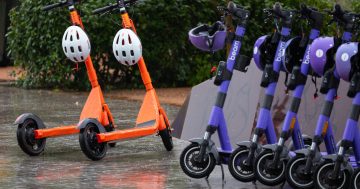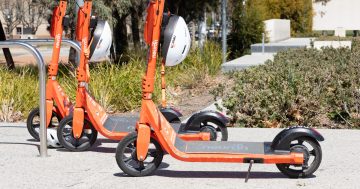
The e-scooter accident scene in Kambah last Sunday. Photo: Ian Bushnell.
Last Sunday’s tragic e-scooter collision which took the life of a 19-year-old rider in Kambah highlights the increased risk on roads and paths from the new travel entrants, and the need for government and police to respond to Canberra’s new traffic environment.
What exactly happened on Sunday is still to be determined and I’m not about to suggest where blame should be apportioned. That is up to police and the coroner.
But the growing number of people using e-scooters is leading to an inevitable rise in injuries and now a death in the ACT, as is happening in other jurisdictions in Australia and overseas.
Their popularity is understandable – they are a fun, agile and cheap way of getting around, with the added feel-good factor of being emission-free.
The ACT has recently expanded the range of the two hire companies operating in the Territory to more suburbs, so riders will be able to travel all the way from Woden to Gungahlin.
The ACT Government says 2.1 million trips on e-scooters have been taken since they were first trialled in the Territory in 2020.
Then there are the private users, many of whom are commuting to work. Throw in the e-bikes and e-skateboards and you can see how more congested our paths are getting.
While scooter riders are not meant to use roads, including bike lanes, they can if there isn’t a path or it isn’t practical to use one.
Of course they are also supposed to observe the traffic rules, wear a helmet and not drink and ride.
But it isn’t uncommon to see riders, like cyclists, flouting those rules, including crossing against the lights, riding tandem or not giving way to pedestrians.
The other factor is speed. Limits exist in the ACT – 10kph when using a crossing, 15kph on footpaths and 25kph on bike paths although some of the private scooters have much higher capability.
Judging distances and the speed of other vehicles and controlling the scooter can all come into play for riders.

Hire e-scooters now range across much of Canberra. Photo: Michelle Kroll.
A raft of new laws were passed in March which introduced new offences for riding the devices without proper control and gave police the power to direct a person to get off an e-scooter.
According to Transport Minister Chris Steel, adjustments to where e-scooters could be ridden and parked were consistently being made, and frequent accident sites were being monitored.
After Sunday’s accident, police ruled out extra safety campaigns for motorists, saying e-scooters generally followed the same rules as cyclists.
“[Police] can go out and enforce and enforce and enforce, but each individual person who uses our roads – whether it be as a pedestrian, e-scooter rider, car or bus driver – has a responsibility to obey those rules,” Detective Acting Inspector Paul Hutcheson said.
Some will call for licensing of e-scooter riders but it is hard to see how that will actually prevent accidents. It would only impose a bureaucratic barrier on riders, and of course would hurt the business model of the hire companies.
The accident adds to calls to keep motor vehicles and vulnerable road users separate but roads will still need to be crossed and used when a path is not available.
But this woman’s death should not be seen as some sort of collateral damage in the ongoing expansion of travel options in the ACT.
The more new entrants, the greater congestion and the higher the risk on our paths and road network.
Everybody should be aware of the rules and everyone should drive defensively. But they aren’t and don’t.
Mr Steel should consider a fresh awareness campaign because the traffic environment has changed and will continue to change.
It should target the new e-travellers, although cyclists would also benefit.
The importance of obeying the traffic rules should be reinforced, especially for people as vulnerable as e-scooter riders.
Any campaign should also send a message to motorists that they need to be alert of the new entrants because any collision could inflict significant injury or even death.
It wouldn’t hurt for police to blitz rule-breaking e-scooter riders to make it clear such behaviour won’t be tolerated.
Risk can never be eliminated but to simply let a more complex traffic environment evolve without any intervention would be negligent.




















